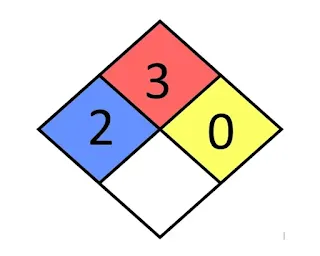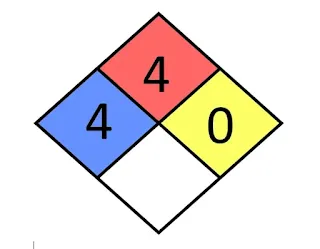On an NFPA 704 symbol what number indicates the greatest hazard
NFPA 704 is the standard that explains the "hazardous materials diamond" established by the National Fire Protection Association (NFPA), used to communicate the risks of hazardous materials. It is important to help maintain the safe use, handling and storage of chemicals. The current edition is 2012 -
The four divisions have colours associated with a number 0 - 4 indicating the severity or degree of hazards.
Note:- To know more details about occupational health and safety topics visit page
What does NFPA level 0,1,2,3,4 Health Hazards indicate?
Blue - refers to health hazards
|
0 |
Materials under whose exposure under fire conditions there is no
danger other than that of ordinary combustible material, such as sodium
chloride |
|
1 |
Materials that cause significant irritation, but only minor
residual damage even in the absence of medical treatment, an example is a glycerin |
|
2 |
Materials under whose intense or continuous exposure can cause
temporary disability or possible permanent damage unless prompt medical
treatment is given, such as chloroform or caffeine (need breathing apparatus) |
|
3 |
Materials that under short exposure can cause temporary or
permanent damage, even with medical attention, such as potassium hydroxide,
need BA (breathing apparatus and chemical suit) |
|
4 |
The element can be lethal (high toxic), with a very short exposure, can cause death or permanent damage, even in case of immediate medical attention. For example, hydrogen cyanide |
What does level 0,1,2,3,4 Flammability Hazards indicate?
Red - indcate the flammability hazards
|
0 |
Materials that do not burn, such as water. Exposed to a temperature of 815 ° C (1,500ºF) for more than 5 minutes |
|
1 |
Materials under whose exposure under fire conditions there is no
danger other than that of ordinary combustible material, such as sodium
chloride. |
|
2 |
Materials that must be moderately heated or exposed to high temperatures before ignition occurs, such as petroleum diesel. Its
flashpoint ranges from 38 ° C (100 ° F) to 92 ° C (200 ° F). |
|
3 |
Liquids and solids that can ignite in almost all ambient temperature conditions, such as gasoline. They have a flashpoint between 24 °
C (73 ° F) and 37 ° C (100 ° F). |
|
4 |
Materials that vaporize rapidly or completely at ambient atmospheric pressor that disperse and burn easily in the air at normal temperatures, such as propane. They have a flashpoint below 23 ° C (73 °
F). |
What does level 0,1,2,3,4 instability Hazards indicate?
|
Yellow the hazard due to reactivity: that is, the instability of the product |
|
0 |
Normally stable, even under exposure to fire and is not reactive with water (e.g., helium). White / Off White The white space may contain the
following symbols |
|
1 |
Normally stable, but can become unstable under conditions
of high temperature and pressure (e.g., acetylene (ethyne) |
|
2 |
Violent chemical change under conditions of high temperature and
pressure (e.g., phosphorus, potassium compounds, sodium compounds |
|
3 |
Capable of detonating or explosively decomposing but requires an ignition source must be heated under confinement Before ignition, it reacts
explosively with water or will detonate if it receives a strong electric
shock (e.g., fluorine) |
|
4 |
Readily capable of detonating or decomposing explosively under normal
temperature and pressure conditions (e.g., nitroglycerin, RDX) |
Note: These three above divisions are assigned a number from 0 (no danger) to 4 (maximum danger).
What does specific Hazard indicate?
|
White - section there may be special indications for some
materials, indicating that they are:
SPECIFIC
Oxidizing - 'OX' or 'OXY' - oxidant, such as potassium
perchlorate or hydrogen peroxide
corrosive - 'COR' - corrosive are either acid or alkaline
Simple Asphyxiating gas - 'SA' - limited to the gases:
nitrogen, helium, neon, argon, krypton and xenon
Reactive with water or radioactive ‘W' - reacts with water in unusual or dangerous ways, such as sodium cyanide or sodium, Potassium, Magnesium etc.
ACID - 'ACID' - such as sulfuric, chromic
ALKALI - 'ALK' - such as potassium hydroxide
NON-SPECIFIC
Biohazard - 'BIO' - such as a virus
Radioactive - 'RAD' - the material is like plutonium
Cryogenic - 'CRYO' or 'CYL' - like liquid nitrogen
Poisonous - 'POI' - eg arsenic
 |
| NFPA Dimond Benzene |
 |
| NFPA Dimond Butane |
 |
| NFPA Dimond H2S |
 |
| NFPA Dimond Sulfuric Acid |



